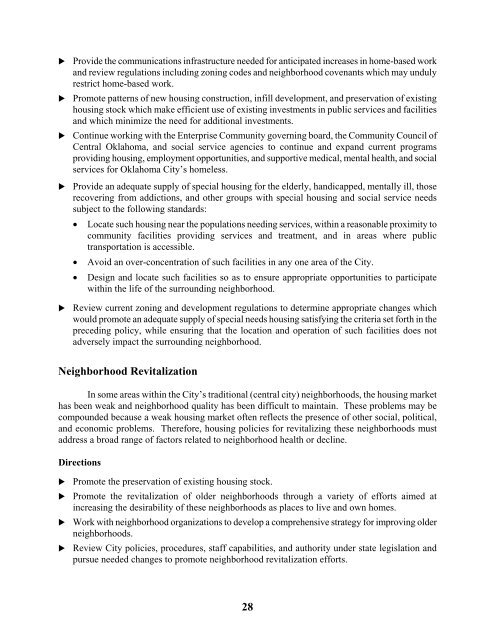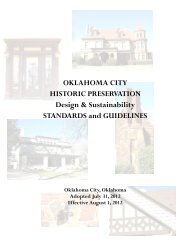OKC Plan, 2000-2020 - City of Oklahoma City
OKC Plan, 2000-2020 - City of Oklahoma City
OKC Plan, 2000-2020 - City of Oklahoma City
Create successful ePaper yourself
Turn your PDF publications into a flip-book with our unique Google optimized e-Paper software.
Provide the communications infrastructure needed for anticipated increases in home-based work<br />
and review regulations including zoning codes and neighborhood covenants which may unduly<br />
restrict home-based work.<br />
Promote patterns <strong>of</strong> new housing construction, infill development, and preservation <strong>of</strong> existing<br />
housing stock which make efficient use <strong>of</strong> existing investments in public services and facilities<br />
and which minimize the need for additional investments.<br />
Continue working with the Enterprise Community governing board, the Community Council <strong>of</strong><br />
Central <strong>Oklahoma</strong>, and social service agencies to continue and expand current programs<br />
providing housing, employment opportunities, and supportive medical, mental health, and social<br />
services for <strong>Oklahoma</strong> <strong>City</strong>’s homeless.<br />
Provide an adequate supply <strong>of</strong> special housing for the elderly, handicapped, mentally ill, those<br />
recovering from addictions, and other groups with special housing and social service needs<br />
subject to the following standards:<br />
• Locate such housing near the populations needing services, within a reasonable proximity to<br />
community facilities providing services and treatment, and in areas where public<br />
transportation is accessible.<br />
• Avoid an over-concentration <strong>of</strong> such facilities in any one area <strong>of</strong> the <strong>City</strong>.<br />
• Design and locate such facilities so as to ensure appropriate opportunities to participate<br />
within the life <strong>of</strong> the surrounding neighborhood.<br />
Review current zoning and development regulations to determine appropriate changes which<br />
would promote an adequate supply <strong>of</strong> special needs housing satisfying the criteria set forth in the<br />
preceding policy, while ensuring that the location and operation <strong>of</strong> such facilities does not<br />
adversely impact the surrounding neighborhood.<br />
Neighborhood Revitalization<br />
In some areas within the <strong>City</strong>’s traditional (central city) neighborhoods, the housing market<br />
has been weak and neighborhood quality has been difficult to maintain. These problems may be<br />
compounded because a weak housing market <strong>of</strong>ten reflects the presence <strong>of</strong> other social, political,<br />
and economic problems. Therefore, housing policies for revitalizing these neighborhoods must<br />
address a broad range <strong>of</strong> factors related to neighborhood health or decline.<br />
Directions<br />
Promote the preservation <strong>of</strong> existing housing stock.<br />
Promote the revitalization <strong>of</strong> older neighborhoods through a variety <strong>of</strong> efforts aimed at<br />
increasing the desirability <strong>of</strong> these neighborhoods as places to live and own homes.<br />
Work with neighborhood organizations to develop a comprehensive strategy for improving older<br />
neighborhoods.<br />
Review <strong>City</strong> policies, procedures, staff capabilities, and authority under state legislation and<br />
pursue needed changes to promote neighborhood revitalization efforts.<br />
28

















